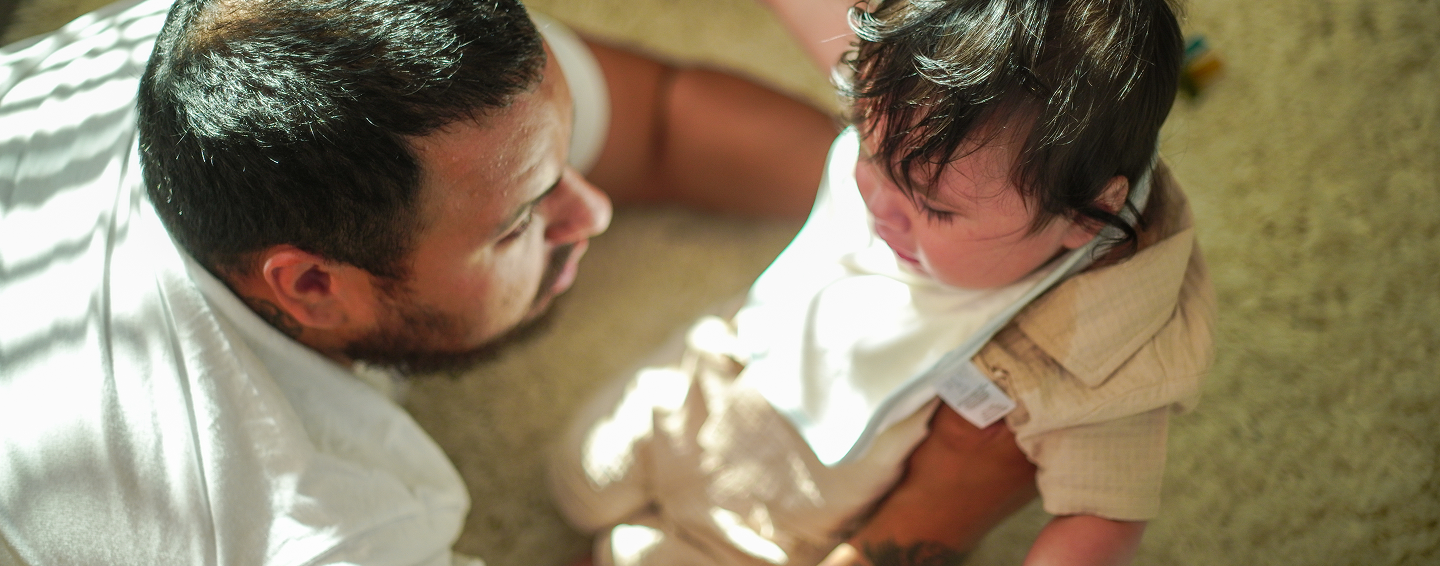Why Travel Sleep Aids Are Essential for Modern Families
Travel sleep aid for babies can be the difference between a peaceful family vacation and a sleepless nightmare. According to research, parents lose an average of 50 hours of sleep in the first 12 months of their child's life - and that's just at home.
Quick Answer for Busy Parents:
- Sound machines with white or pink noise help mask unfamiliar sounds
- Portable bassinets provide safe, flat sleep surfaces away from home
- Blackout covers block hotel room light for better daytime naps
- Red light nightlights support natural sleep cycles without disruption
- Never use sedatives - the American Academy of Pediatrics warns against medicating babies for travel
When you're dealing with new surroundings, different time zones, and disrupted routines, your baby's sleep can fall apart fast. Hotel rooms are bright. Airplanes are loud. Grandma's house has unfamiliar sounds and smells.
The good news? Safe, effective travel sleep aids exist that don't involve risky medications or complicated setups. From clip-on sound machines that recreate womb-like heartbeats to portable blackout tents that turn any space into a cozy sleep cave, the right tools can help your little one (and you) rest better on the road.
I'm Gary Harutyunyan, and after struggling with my own newborn's sleep challenges, I created innovative solutions including rhythmic patting devices that work as an effective travel sleep aid for babies.
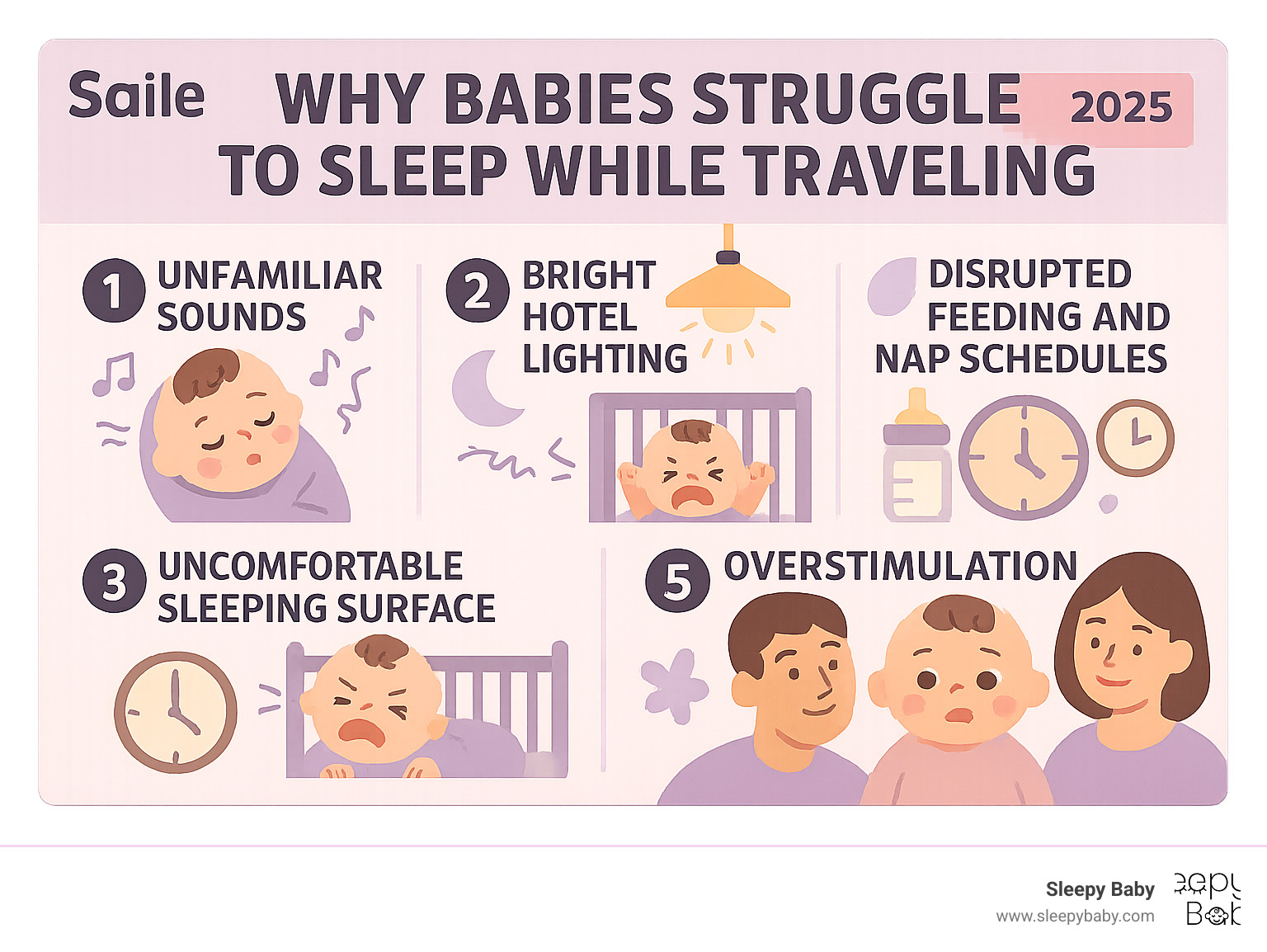
Safe Sleep Fundamentals Away From Home
Before we dive into specific products, let's talk about the non-negotiables for safe baby sleep while traveling. The American Academy of Pediatrics' safe sleep guidelines don't take a vacation just because you do.
Your baby needs a flat, firm surface whether you're at home or in a hotel room halfway around the world. Avoiding car seats, swings, and other products not designed for unsupervised sleep is crucial.
The research backs this up: Scientific research on air travel safety shows that air travel is typically safe for healthy, full-term infants after the first few weeks of life. However, premature babies and those with heart or lung conditions need medical clearance before flying.
Is it Safe to Sedate My Baby for Travel?
The American Academy of Pediatrics officially does not recommend sedating children for travel. Diphenhydramine (commonly known as Benadryl) can have unpredictable and sometimes dangerous reactions in infants and toddlers. Instead of making babies sleepy, it can actually cause paradoxical hyperactivity.
Scientific research on sedation risks reveals that diphenhydramine can concentrate in the fluid around an infant's brain, leading to potentially fatal outcomes. Children under two are at particularly high risk.
If you're considering any medication, consult your pediatrician first, verify correct weight-based dosing, and do a home trial run to watch for side effects.
Products Not Intended for Sleep: What to Avoid
Car seats present a real concern when used for sleep. The semi-upright position can cause a baby's head to fall forward, potentially blocking their airway. For premature or medically vulnerable infants, limit car rides to under 30 minutes and have an adult monitor them closely.
Strollers, swings and bouncers should never be used for unsupervised sleep due to their angled positions. Slings and carriers, while wonderful for keeping baby close during travel, aren't safe for sleep either due to suffocation risks.
Features to Look For in Any Travel Sleep Aid
When choosing a travel sleep aid for babies, prioritize these safety features:
Breathable mesh or fabrics with proper airflow are non-negotiable. Noise level controls are essential for sound machines - they should stay at or below 50 decibels. Long battery life of at least 8-10 hours prevents the nightmare scenario of your sleep aid dying mid-nap.
Child lock features become crucial once your little one becomes mobile. Red light options support the body's natural circadian rhythm without disrupting sleep like blue or white light can.
Choosing the Right Travel Sleep Aid for Babies
Finding the perfect travel sleep aid for babies doesn't have to be overwhelming. The secret is selecting tools that bring familiar comfort from home while being practical enough to fit in your diaper bag.
Think about what already helps your baby sleep at home. The best travel sleep aids recreate these familiar cues in unfamiliar places.
How Sound Machines and White/Pink Noise Work
Your baby spent nine months surrounded by the constant whoosh of blood flow and muffled sounds in the womb. That's why many newborns actually sleep better with background noise than in complete silence.
White noise creates a consistent sound blanket that masks those jarring hotel hallway conversations or airplane engine changes. But pink noise might be even better - it's deeper and more natural, like gentle rain or wind through trees. Research shows pink noise may block external disturbances more effectively than white noise.
The magic happens when your baby starts associating that familiar sound with sleep time. Once they make that connection, you can use the same sound cue whether you're in a busy airport or a quiet mountain cabin.
Safety is key when using sound machines. Keep the device at least arm's length from your baby's ears, maintain volume at conversational levels (around 50 decibels), and use timer functions to avoid all-night exposure.
The beauty of a good sound machine is its versatility. More info about portable sleep soothers can help you choose the right features for your family's travel style.
Portable Bassinets, Playards & Blackout Covers
Travel bassinets must meet safety regulations and should always sit on a hard, flat surface on the floor. Look for models that fold compactly and include fitted sheets designed specifically for that bassinet. The best ones have breathable mesh panels and sturdy, certified hardware.
Blackout covers are game-changers for families who travel frequently. These products can transform any sleep space into a dark, cozy environment. The best blackout covers block 95% or more of light while maintaining proper airflow through adjustable ventilation panels.
Easy setup is crucial when you're tired and dealing with a cranky baby in an unfamiliar place.
Natural Options: Aromatherapy and Red Light
Essential oil linen sprays designed specifically for babies (3+ months) can help recreate familiar scents from home. Look for organic, melatonin-free formulas with chamomile or lavender.
Red light therapy supports your baby's natural circadian rhythm without the sleep-disrupting effects of blue or white light. Some portable devices combine red light with sound machines for a comprehensive sleep solution.
Always check age recommendations and consult your pediatrician before using any aromatherapy products with babies.
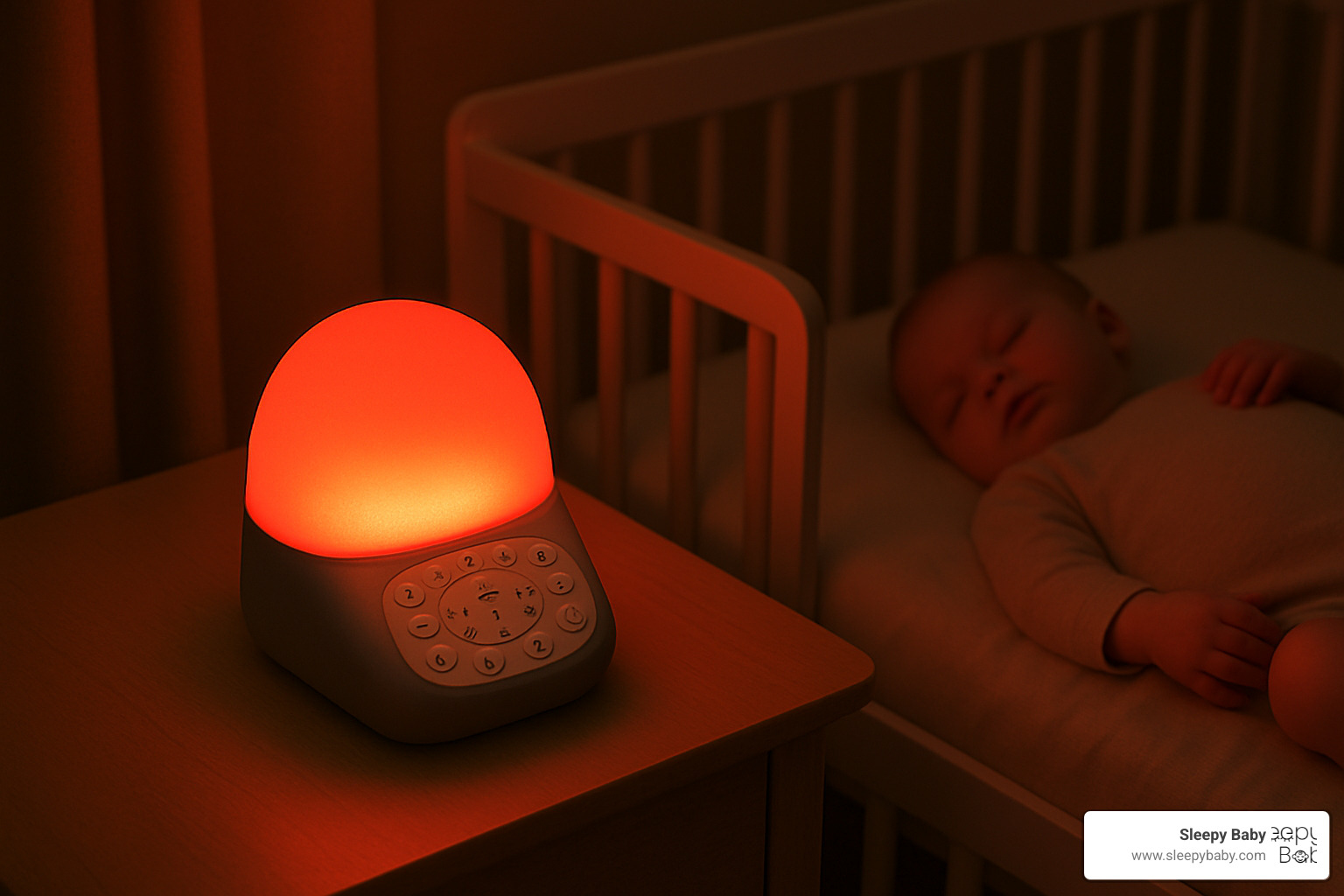
Maintaining Your Baby's Sleep Routine While Traveling
The secret to successful travel with babies isn't luck - it's consistency. When everything else changes around your little one, familiar sleep cues become their anchor to comfort and rest.
Pre-Trip Prep: Practice With the Travel Sleep Aid for Babies
Start using your chosen travel sleep aid for babies at home at least a week before you travel. If you've selected a sound machine, play the same soothing sounds during regular naps. If you're using a rhythmic patting device, let your baby get used to the gentle motion during their usual bedtime routine.
More info about portable sleepers shows that consistency between home and travel setups makes all the difference. Your baby should already love their travel sleep aid before you even pack your bags.
Practice setting up your travel gear at home too. Test the battery life during your longest sleep stretch at home - nothing ruins a peaceful night like a dead device at 3 AM.
On the Move: Planes, Cars, and Trains
Air travel can actually work in your favor. The steady hum of airplane engines creates natural white noise that many babies find soothing. The key is managing ear pressure during takeoff and landing - offer feeding or a pacifier during these times.
For premature babies, stick to the 30-minute limit for time spent in car seats, and always have an adult watching them closely.
Want more detailed flight strategies? Check out Airborne Naps: How to Help Your Baby Sleep on a Plane for specific tips.
Car travel requires strategic stops every couple hours. Train travel often provides the gentlest option - that rhythmic motion mimics the swaying many babies loved in the womb.
After Arrival: Adjusting to New Environments and Jet Lag
Set up your familiar sleep environment immediately when you arrive. Don't wait until bedtime to figure out where the sound machine goes or how to darken the room.
Light exposure becomes your secret weapon against jet lag. Take your baby outside during local daytime hours. Natural sunlight helps reset their internal clock faster than any other method.
Gradual bedtime shifts work better than dramatic changes. If you're dealing with a significant time difference, move bedtime by 15-30 minutes each day toward the local schedule.
Keep your bedtime bath routine if that's part of your home schedule. The warm water and familiar ritual signal that sleep time is coming.

Hotel Rooms, Campsites & Grandma's House: Safe Setups
Every new sleep environment requires a safety assessment and setup strategy. Here's how to create safe, comfortable sleep spaces wherever you are.
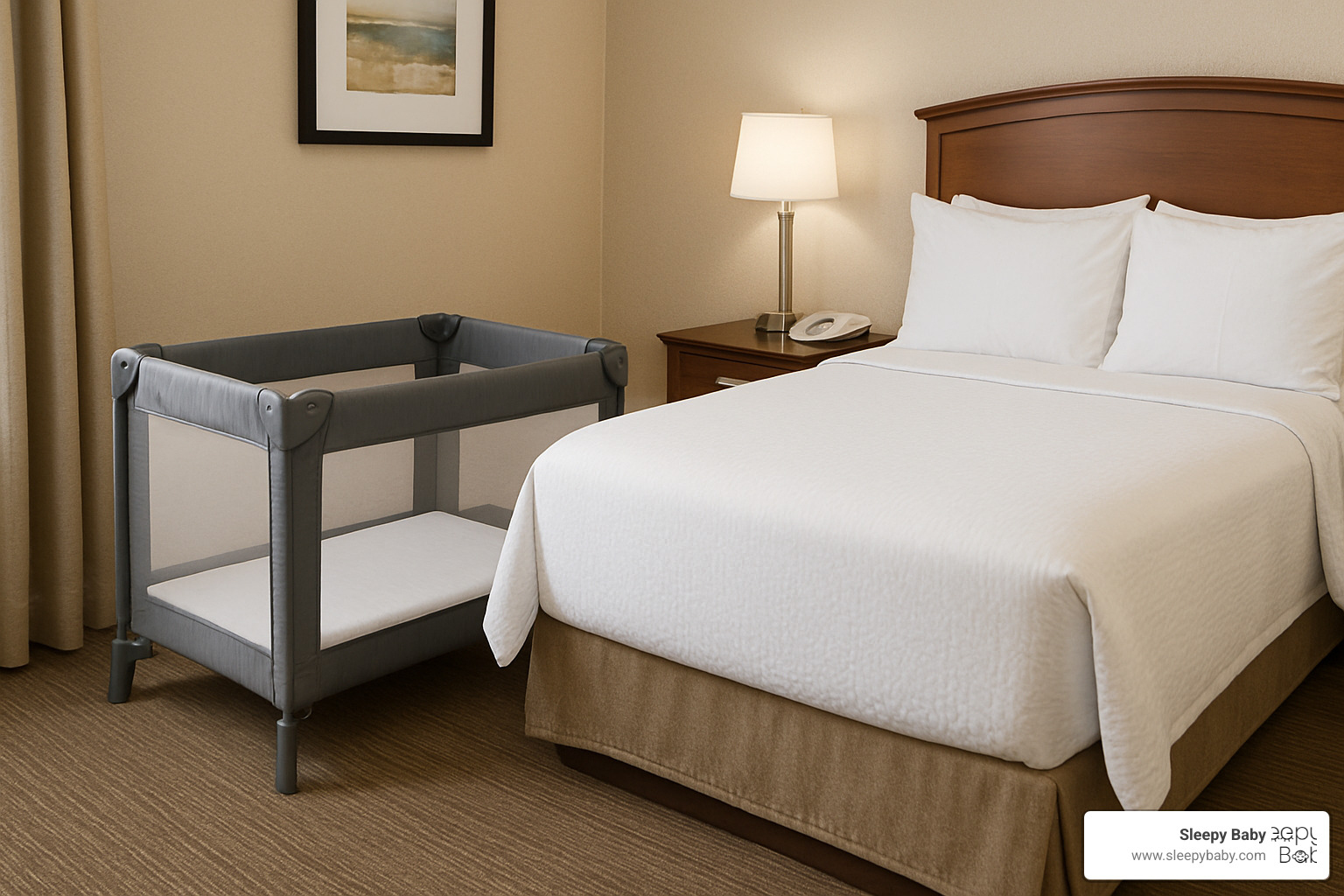
Before you even unpack your travel sleep aid for babies, do a quick walk-through of the space. Check the room temperature - babies sleep best between 68-70°F (20-21°C). Position the sleep area away from windows, heaters, and air conditioning vents.
Quick-Check Checklist for Each New Room
Hazard identification comes first - scan for loose cords, blind strings, or anything that could pose a strangulation risk. If you're staying somewhere with older electrical outlets, bring your own outlet covers.
Environment setup is your next priority. Make sure any borrowed cribs meet current safety standards. Remove any loose bedding, pillows, or decorative items from the sleep area.
Lighting control can make or break your baby's sleep in a new place. Hotel rooms are notoriously bright. Use blackout curtains or portable blackout covers to darken the room.
Position your travel sleep aid for babies where you can see and hear your little one clearly, but away from any potential hazards. Sound machines should be at least arm's length from your baby's ears.
What to Do If Baby Falls Asleep in a Car Seat or Stroller
Always transfer them to a proper sleep surface as soon as you reach your destination. Car seats and strollers aren't designed for unsupervised sleep. The semi-upright position can cause breathing difficulties, especially in younger babies.
During transport, if you must continue traveling with a sleeping baby in a car seat, make sure an adult can monitor them continuously.
Here's a prevention strategy: time your departures to coincide with your baby's natural wake periods when possible.
Outdoor Trips: Camping & Day Trips
Essential gear makes all the difference. Portable fans for air circulation, bug nets or screens, battery banks to keep your sleep aids charged, and layered clothing for temperature regulation.
Safety considerations are even more important outdoors. Never leave babies unattended in tents or outdoor sleeping areas. Ensure proper ventilation in any enclosed sleeping space, and always have a backup plan for extreme weather.
Setup tips: Choose the flattest, most protected area for your baby's sleep space. Test all equipment before your trip. Bring extra batteries or charging options.
Frequently Asked Questions
Are Travel Sleep Aids for Babies Safe to Use Overnight?
Yes - when you follow the manufacturer's guidelines and use common sense. Most travel sleep aids for babies are specifically designed for overnight use, but safety depends on proper setup and age-appropriate products.
Sound machines are generally the safest option for overnight use. Keep them positioned at least arm's length away from your baby's sleep area and never place them inside the crib.
Portable bassinets and sleep surfaces must meet current safety standards and should always be placed on firm, flat floors - never on beds or other liftd surfaces.
The golden rule: if the device needs to be in or attached to your baby's sleep space, it's probably not safe for unsupervised overnight use.
What Volume Should a Travel Sleep Aid for Babies Be Set To?
Keep your sound machine at 50 decibels or lower - that's about the volume of a quiet conversation. The easiest way to test this is the arm's length rule: stand an arm's length away from the device and try to have a normal conversation. If you have to raise your voice, it's too loud.
Travel environments can be tricky because they're often noisier than home. Instead of cranking up the volume, position your sound machine strategically between the noise source and your baby.
Pink noise often works better than white noise for masking irregular sounds like conversations or traffic.
Should I Pack My Own Crib Mattress or Use Hotel Gear?
For short trips (1-3 nights), hotel cribs are usually fine if they pass your safety inspection. Check that the mattress fits snugly with no gaps larger than two fingers between the mattress and crib sides. The surface should be firm.
Look for current safety certification labels and inspect the crib for broken or missing parts. Slats should be no more than 2⅜ inches apart.
For longer stays or if you have a particularly sensitive sleeper, bringing your own portable travel mattress can give you peace of mind.
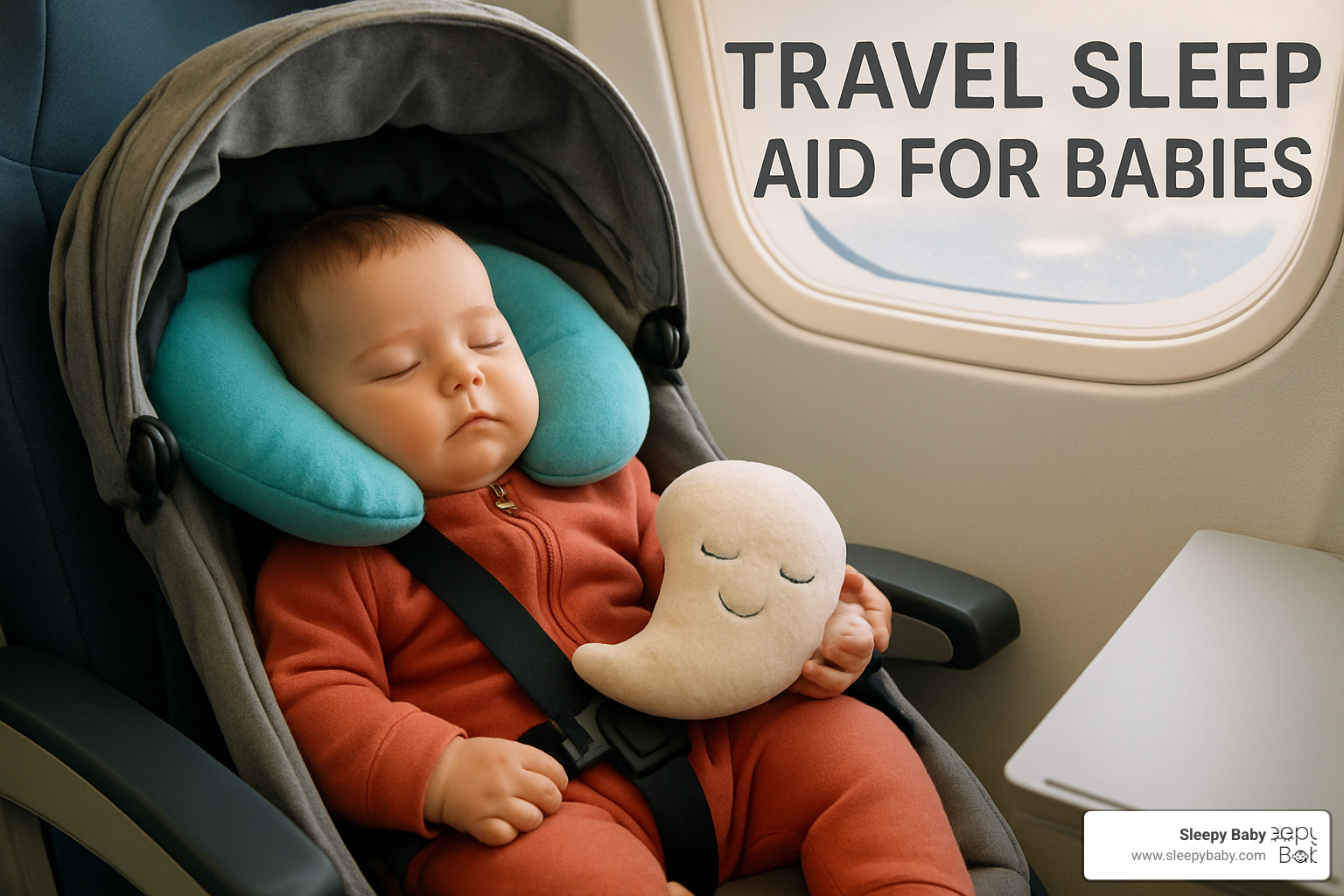
Conclusion
Traveling with babies doesn't have to mean sacrificing sleep for the whole family. The right travel sleep aid for babies can transform what feels like an impossible situation into manageable family trips.
The secret isn't finding the perfect solution - it's finding the right combination of tools and strategies that work for your unique little one.
At Sleepy Baby, we created our portable sleep solutions because we understand that babies crave the familiar comfort of rhythmic patting and soothing sounds, even when they're miles from home. Whether you're dealing with a bright hotel room, a noisy airplane cabin, or that guest bedroom at grandma's house, having familiar sleep cues can be the difference between a peaceful night and a 3 AM meltdown.
The most important thing to remember? Safety always comes first. Never use sedatives or let your baby sleep unsupervised in car seats, swings, or other products not designed for sleep.
Consistency is your secret weapon. Practice with your travel sleep aids at home first. Let your baby get used to that white noise sound or rhythmic patting motion before you're dealing with jet lag and new surroundings.
Flexibility helps everyone. Your baby might need different volume levels in a hotel room than at home, or they might take longer to settle in unfamiliar surroundings. That's completely normal.
Patience pays off. It may take a few nights to establish good sleep patterns in new places. Some babies adapt quickly, while others need more time to feel secure. Either way is okay.
The goal isn't perfection - it's progress. Even if your baby's sleep isn't exactly the same as at home, having the right tools and strategies can help everyone get enough rest to actually enjoy your travels together.
For more detailed guidance on specific travel scenarios and choosing the right sleep aids for your family's needs, explore our comprehensive resources: More info about the best baby sleep aid for travelling.
Sweet dreams and safe travels!


